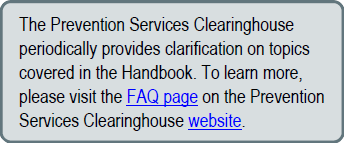 For each program or service identified and prioritized for inclusion, Prevention Services Clearinghouse staff conducts a comprehensive and systematic search for potentially eligible studies of that program or service. All search results are carefully documented in databases to ensure transparency. Duplicate citations are removed before screening them for eligibility.
For each program or service identified and prioritized for inclusion, Prevention Services Clearinghouse staff conducts a comprehensive and systematic search for potentially eligible studies of that program or service. All search results are carefully documented in databases to ensure transparency. Duplicate citations are removed before screening them for eligibility.
Other Clearinghouses. The search begins by identifying citations from other evidence clearinghouses or repositories. A number of evidence clearinghouses overlap in content with the Prevention Services Clearinghouse (see Exhibit 3.1). Identifying studies that these other clearinghouses have reviewed is an efficient way of locating studies that may meet Prevention Services Clearinghouse eligibility criteria.
Exhibit 3.1. Clearinghouses Used to Identify Relevant Research
Clearinghouse* | Website |
|---|---|
Blueprints for Healthy Youth Development (Blueprints) | |
California Evidence-Based Clearinghouse for Child Welfare (CEBC) | |
Home Visiting Evidence of Effectiveness Review (HomVEE) | |
Child Trends What Works | |
CrimeSolutions | |
Teen Pregnancy Prevention (TPP) Evidence Review | |
Washington State Institute for Public Policy (WSIPP) | |
The Campbell Collaboration | |
The Cochrane Collaboration |
*Note: Additional clearinghouses may be used, depending on the program or service selected.
Bibliographic Databases. To ensure that searches are comprehensive, Prevention Services Clearinghouse staff also conduct searches of electronic bibliographic databases to identify additional potentially eligible studies not included on other clearinghouse sites. Trained staff use keywords to execute the searches. Content experts review these search terms for completeness, identify common synonyms, and suggest additional keywords. The following databases are included in all searches, with additional databases added as content experts recommend.
Exhibit 3.2 Bibliographic Databases Used to Identify Relevant Research
Database* | Website |
|---|---|
Applied Social Sciences Index and Abstracts (ASSIA) | https://www.proquest.com/products-services/ASSIA-Applied-Social-Sciences-Index-and-Abstracts.html |
Cumulative Index to Nursing and Allied Health Literature (CINAHL) | |
Education Resources Information Center (ERIC) | |
MEDLINE Complete (PubMed) | |
National Criminal Justice Reference Service (NCJRS) | |
PsycINFO | |
Social Sciences Citation Index (SSCI) |
*Note: Additional databases may be used, depending on the program or service selected.
Grey Literature Scans. Finally, Prevention Services Clearinghouse staff scan the websites of federal, state, foundation, and private agencies who sponsor or conduct relevant research in order to identify any additional potentially eligible studies that may not be indexed in the standard electronic databases.
